Composition
by Michael Frye | Oct 29, 2023 | Composition, Travels and Stories
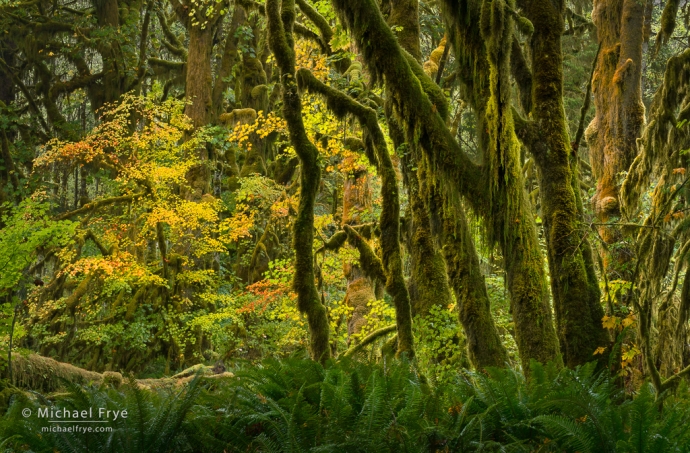
Vine maples and big-leaf maples, autumn, Olympic NP, Washington
Earlier this month, Claudia and I spent about two weeks on the Olympic Peninsula in Washington. Part of that time I was co-leading a workshop for Visionary Wild with Jerry Dodrill, which was super fun. We had a great, lively group of people, and beautiful conditions, with lots of fall color, and a gorgeous sunset on the beach.
This was our second trip to the Olympic Peninsula this year, and we loved both visits. There’s something about temperate rain forests that seems to strike a chord with me, whether on the Olympic Peninsula, in the redwoods, or on the west coast of New Zealand.
(more…)
by Michael Frye | Sep 3, 2023 | Composition
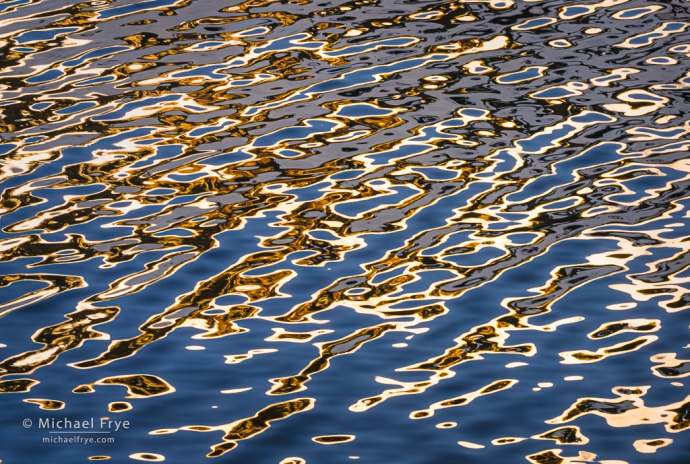
Ripples and reflections in an alpine lake, Inyo NF, California. 227mm, 1/125 sec. at f/22, ISO 1250.
During our Range of Light workshop in July we found some striking reflections in a mountain lake. These weren’t mirror reflections, because a nearby cascade was pouring into the lake, rippling the surface of the water. But that’s actually what made the reflections so interesting. The ripples created squiggly lines and shapes in the water, as the surface reflected blue sky and late-day, golden light shining on rocks and snowbanks across the lake.
It was a great situation for making abstract images, so I encouraged our participants to zoom in with a long lens to try to capture the patterns. While I often like using slow shutter speeds for water images, capturing these ripples required fast shutter speeds to freeze the water’s motion and preserve the intricate patterns. And the patterns would be more prominent if everything was in focus, which required stopping down the aperture to get as much depth of field as possible.
(more…)
by Michael Frye | Jun 8, 2023 | Composition
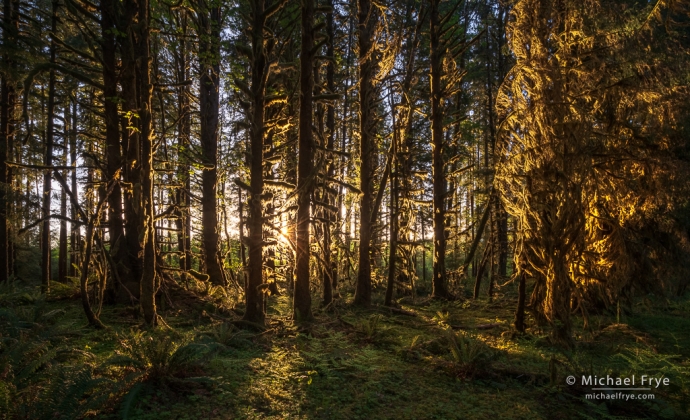
Sun setting in a temperate rainforest, Olympic NP, Washington
After our Death Valley workshop, wildflower odysseys, and quick trip to Tucson for the NANPA Summit, Claudia and I flew up to Seattle and drove to the Olympic Peninsula for the Out of Olympic photography conference.
That was such a fun event, with a great group of participants, and wonderful instructors. It was great to meet or reconnect with so many good people. And, as usual, the conference was really well organized by Chris Smith and his Out of Chicago team.
(more…)
by Michael Frye | Jun 12, 2022 | Composition, Light and Weather
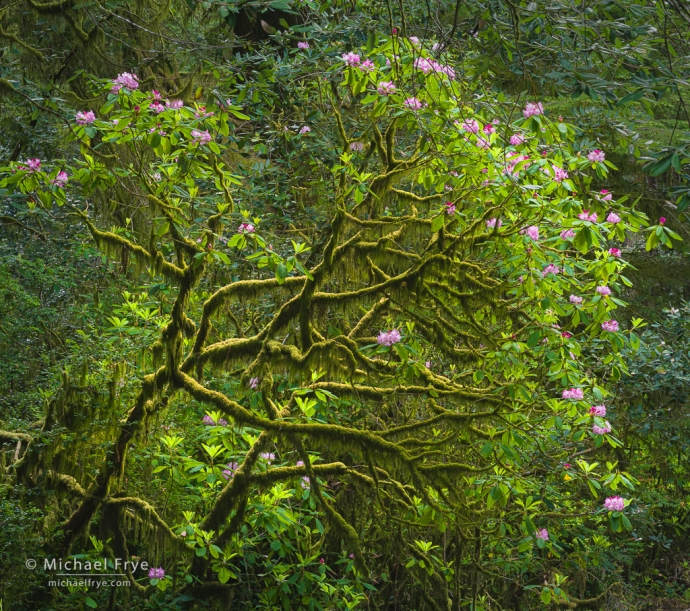
Lichen-covered rhododendron, Northern California. This was an overcast day, and the soft, even light helped simplify this complex scene, and emphasize the color contrasts between the pink rhododendrons and various shades of green. I used a long lens to isolate the rhododendron against a dark, leafy background. Moving closer with a shorter lens would have required looking up at the top of the tree, forcing me to include bright, distracting patches of sky. 159mm, 1/4 sec. at f/16, ISO 800, polarizing filter to cut reflections on the leaves.
Forests can be challenging to photograph. They’re beautiful, but cluttered, and often visually chaotic.
Creating order out of that chaos requires finding ways to simplify things. That’s one of the reasons fog is so helpful for these scenes: it obscures the background, reducing the clutter. (It also lends a wonderful atmosphere to the photographs.)
During our recent workshop in the redwoods we did get some fog, and even sunbeams. I’m sure I’ll post some of those photos down the road.
But there were also many occasions before, during, and after the workshop when we didn’t have fog, and I was photographing forests in soft light, or with sunlight filtering through the trees. What then?
(more…)
by Michael Frye | Feb 6, 2022 | Composition
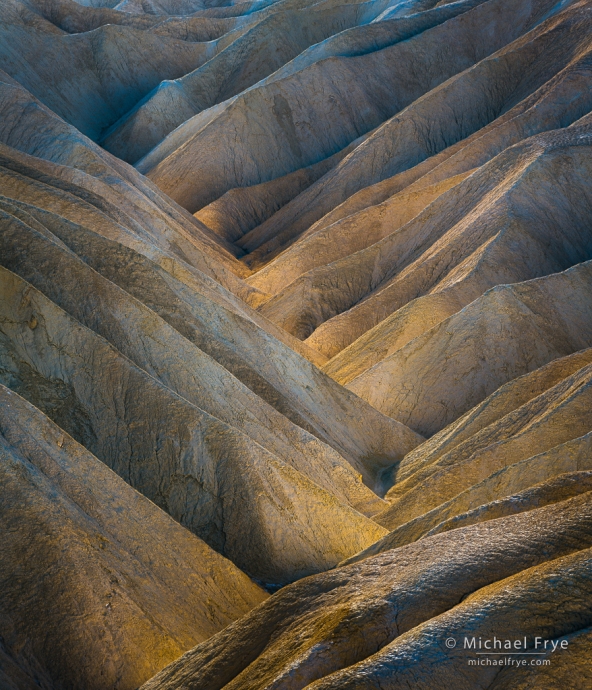
Luminous ravine, Death Valley, California. The repeating diagonals and V-shapes create a strong pattern, while the curve of the ravine adds another design element.
Death Valley’s landscapes are elemental. You’re often photographing bare earth: rocks, sand, dirt, mud, and salt. Those things don’t sound very photogenic – not like, say, photographing a snowy mountain peak, or a rugged sea coast.
But in photography, light, composition, and design are more important than the subject. You can have a great subject (like that snowy mountain peak, for example), but if the light or composition are mediocre the photograph will be mediocre as well. On the other hand, a “mundane” subject can make an amazing photograph – with good light and a strong design.
Death Valley is full of “mundane” subjects like rocks, salt flats, badlands, and piles of sand. But wind and water have sculpted those elements into wonderful shapes and patterns. It’s a great place to learn to think abstractly. In other words, instead of thinking about subjects, you can concentrate on finding lines, shapes, and patterns, and putting those elements together to create strong designs.
(more…)
by Michael Frye | May 26, 2020 | Composition, Light and Weather
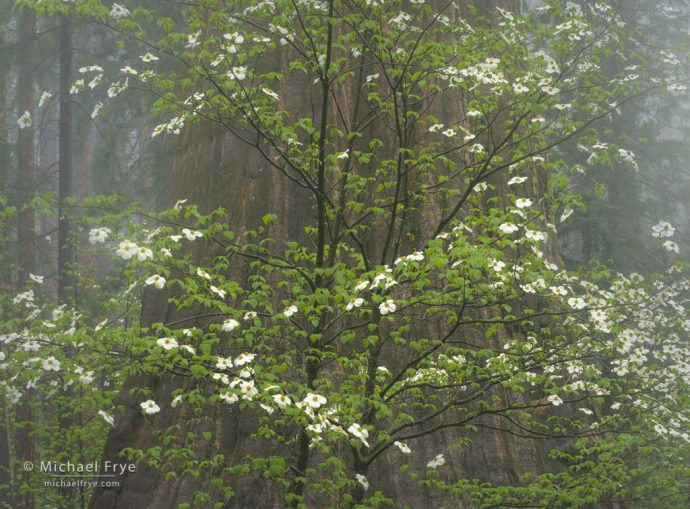
Dogwood and giant sequoia in the fog, Sierra Nevada, California. Fog is a wonderful complement to forest scenes; here, some ephemeral fog lasted just long enough for me to capture this image. 70mm, polarizer, 0.7 seconds at f/16, ISO 100.
People seem to love trees and forests. I know I do.
But forests can be difficult to photograph. Natural forests are usually a study in chaos, with haphazard arrangements of branches, trunks, logs, and leaves. There’s an organic order to all that, with trees and understory plants growing to take advantage of small patches of sunlight, and a cycle of birth, growth, death, and decay.
But visual order can be hard to find amid all that clutter. The chief challenge in photographing forests is usually finding a way to simplify things, and make order out of chaos.
(more…)














